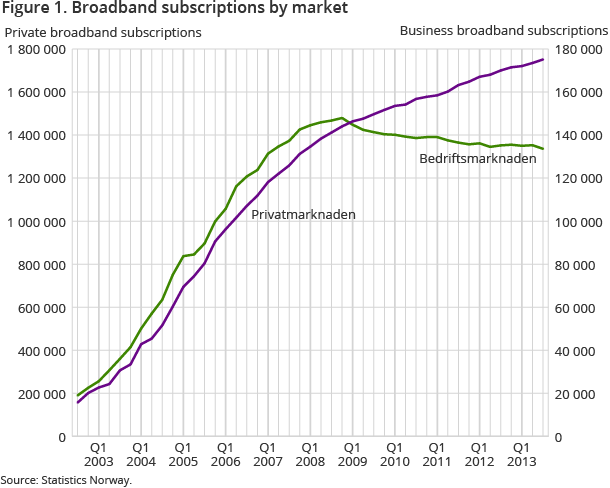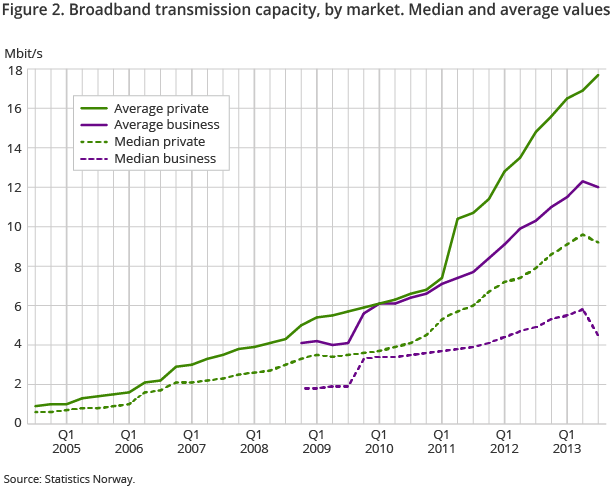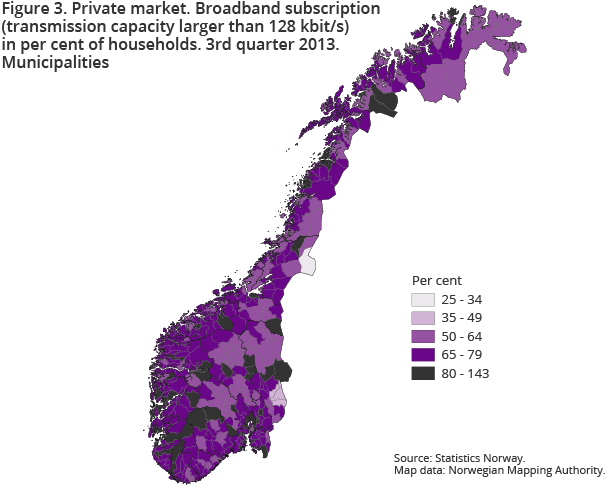Content
Published:
This is an archived release.
Change in offer reduces broadband speed
A new price structure by two Internet service providers has resulted in a drop in some broadband capacity figures. The number of private fixed broadband connections has increased by 16 000 in the last quarter. The average capacity of private fixed broadband access has increased 20 per cent in the past year. For business broadband, the increase was 17 per cent.
| 3rd quarter 2013 | 2nd quarter 2013 | 3rd quarter 2012 | 3rd quarter 2012 - 3rd quarter 2013 | ||
|---|---|---|---|---|---|
| Change | Change i per cent | ||||
| Fixed broadband | 1 886 050 | 1 871 375 | 1 836 585 | 49 465 | 2.7 |
| Private broadband | |||||
| Private broadband subscriptions | 1 752 352 | 1 735 985 | 1 701 288 | 51 064 | 3.0 |
| Private broadband subscriptions per 100 households | 77.5 | 76.8 | 76.0 | 1.5 | 2.0 |
| Average transmission capacity (Mbit/s) | 17.7 | 16.9 | 14.8 | 2.9 | 19.6 |
| Median transmission capacity (Mbit/s) | 9.2 | 9.6 | 7.9 | 1.3 | 16.5 |
| Business broadband | |||||
| Business broadband subscriptions | 133 698 | 135 390 | 135 297 | -1 599 | -1.2 |
| Average transmission capacity (Mbit/s) | 12.0 | 12.3 | 10.3 | 1.7 | 16.5 |
| Median transmission capacity (Mbit/s) | 4.5 | 5.8 | 4.9 | -0.4 | -8.2 |



51 000 more private fixed broadband subscriptions in a year
The number of private broadband subscriptions with fixed access in Norway, including Svalbard, was 1 752 000 at the end of the 3rd quarter of 2013; an increase of 51 000 subscriptions in the last 12 months. Compared to the previous quarter, this is an increase of 16 000 subscriptions.
The number of business subscriptions is down to 134 000. This is the lowest figure since the first quarter of 2007.
Change in offer leads to reduced broadband capacity
One of the most important providers of private broadband has changed its price and capacity offer to its customers. This change has a direct effect on the calculation of the median value for private broadband capacity. The average value is not affected in the same way. The average transmission capacity for fixed private broadband has increased from 16.9 to 17.7 Mbit/s since the previous quarter. At the same time, the median value has decreased to 9.2 Mbit/s from 9.6 in the previous quarter. One year ago, the average transmission capacity was 14.8 Mbit/s and the median value was 7.9 Mbit/s.
Another supplier of business broadband has also adjusted its price structure. For this market, both the average and the median values are directly affected. The average transmission capacity for fixed business broadband has decreased to 12.0 from 12.3 Mbit/s in the previous quarter. At the same time, the median value decreased to 4.5 Mbit/s compared to 5.8 in the previous quarter.
Private broadband subscriptions with a capacity of more than 8 Mbit/s total 52 per cent; a decrease from 54 per cent in the previous quarter. Only 36 per cent of business broadband subscriptions have this capacity; a decrease from 38 per cent in the previous quarter.
The broadband penetration rate in private households is 77 per cent, which is an increase from last year’s 76 per cent. The figure for private broadband subscriptions per 100 households varies between 86 per cent in the county of Oslo and 64 per cent in the county of Finnmark.
Not all providers are included Open and readClose
The number of Internet service providers reporting to this survey has been around 200 over the past few years. Market changes have reduced this number to around 170. A few small, but potentially locally important Internet service providers, mostly cable TV providers, may still not be included in the survey. Efforts have been made to include these providers. Some small errors related to the distribution of subscribers between municipalities may occur. This can have major consequences for the figures per household for some municipalities.
Contact
-
Statistics Norway's Information Centre
E-mail: informasjon@ssb.no
tel.: (+47) 21 09 46 42
